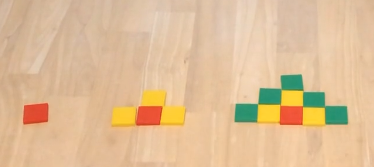We play a game in stations to practice skip counting called “Cross the Creek” or “Cross the Galaxy.” Basically we rename it based on the shape of the foam tiles. The way the game works is that you write multiples of a number or a counting pattern on one side of craft foam pieces. You then lay it out face up so that students can practice seeing and counting. Students take turns walking across the numbers and saying them as they walk. After they cross, they can choose one number to turn over and then the next person goes. It’s a really great kinesthetic way to get kids to practice counting patterns after they have had time to conceptualize the pattern.
I say all of that to set up this next 3 Act task. I thought, a predictable sequence would be fun, but I want to start out with a number pattern that encourages students to think about the nature of patterns. For that reason, there will be two different videos for Act 2 based on student responses to what information they need. The first will give them just the second number and the next will give them the first three numbers. The goal is to get them to see that patterns cannot be discerned by simple looking at two numbers (or three in cases like the Fibonacci sequence – but that will be explored at a different time:). There are many standards this task addresses, it can be used at any grade for MP 8. Or for content standards in several grades in Operations and Algebraic thinking. Specifically 2.OA.A.1.
Star Pattern Google Slide Deck
Act 1
What do you notice? What do you wonder?
What is the number on the yellow star?
Estimate.
Act 2.0
What do you know? What do you need to know?
2.1
Are you confident in your answer after seeing this new information or would you like to revise?
Act 3




